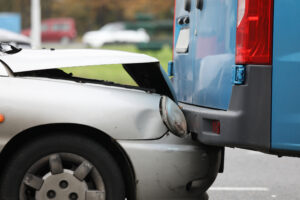
IIHS: Front crash prevention systems less effective at preventing large truck, motorcycle collisions
By onAnnouncements | Market Trends | Technology
Front crash prevention systems aren’t as effective at preventing collisions with large trucks and motorcycles as they are at avoiding crashes with cars, new research shows.
The Insurance Institute for Highway Safety (IIHS) said it conducted two studies that show a discrepancy in forward collision warning and automatic emergency braking (AEB) system effectiveness, depending on vehicle type.
While such systems were found to reduce rear-end crashes by 53% in cases involving other passenger vehicles, they reduce such accidents by just 38% in situations involving medium or heavy-duty trucks, IIHS said. For passenger vehicle crashes involving motorcycles, they reduce the accident rate by 41%, the studies showed.
“These reductions are impressive for all vehicle types, but the safety benefits could be even larger if front crash prevention systems were as good at mitigating and preventing crashes with big trucks and motorcycles as they are with cars,” said Jessica Cicchino, IIHS’ vice president of research.
According to IIHS, more effective systems could prevent 5,500 crashes per year involving medium or heavy trucks and another 500 collisions involving motorcycles. It could also help reduce fatalities associated with such accidents, it said.
“Motorcycles and large trucks present unique risks,” Cicchino said. “Along with being hard for other drivers to see, motorcycles don’t have a steel frame surrounding and protecting the rider the way cars do. At the other end of the spectrum, large trucks are so massive that when a passenger vehicle hits one, it’s more likely to be fatal to the people inside the passenger vehicle. The height of large trucks can also result in dangerous underride crashes.”
IIHS said it conducted its research, meant to determine how front crash prevention systems are addressing real-world crashes, by comparing relevant police reports for model year 2016 through 2020 passenger vehicles. It included vehicles with and without AEB and FCW systems.
IIHS said that when it began evaluating front crash prevention systems 10 years ago, few vehicles were equipped with them. Conversely, nearly every new vehicle comes equipped with the feature today, it added.
To ensure the systems are equally capable of preventing crashes with large trucks and motorcycles, and to address the large portion of rear-end crashes at higher speeds, IIHS said it is conducting a new vehicle-to-vehicle front crash prevention evaluation. It plans to publish its first ratings early next year.
As part of that process, it worked with Transport Canada to determine how various front crash prevention systems on five 2021-22 models reacted to different vehicles and surrogate targets. The tests were conducted at 31 mph, 37 mph and 44 mph.
The study showed that front crash prevention systems can’t detect other vehicle types as well as standard passenger car targets, and that they were less likely to sound an alert when a collision with certain large vehicles or motorcycles was imminent.
“Motorcycles are smaller and narrower than cars, making them more difficult for camera- and radar-based systems to identify, especially at higher speeds,” said IIHS Senior Research Scientist David Kidd. “Extra-large vehicles are presumably easier to detect, but their dimensions appear to confuse the systems’ algorithms.”
The study found that when test vehicles approached a standard passenger target, they sounded forward collision warning alerts 90% of the time. Conversely, it triggered a warning for a school bus, fire truck, tractor-trailer or dry van trailer less than 80% of the time and approximately 70% with motorcycles.
“This research shows that front crash prevention testing programs need to use a variety of targets representing different vehicle types to ensure good performance in the real world,” Kidd said. “Our updated test will make use of the two standard motorcycle targets as well as a new passenger car target, and we’ll evaluate warning responses to a real tractor-trailer.”
Images
Featured illustration courtesy of ivan-Balvan/iStock
